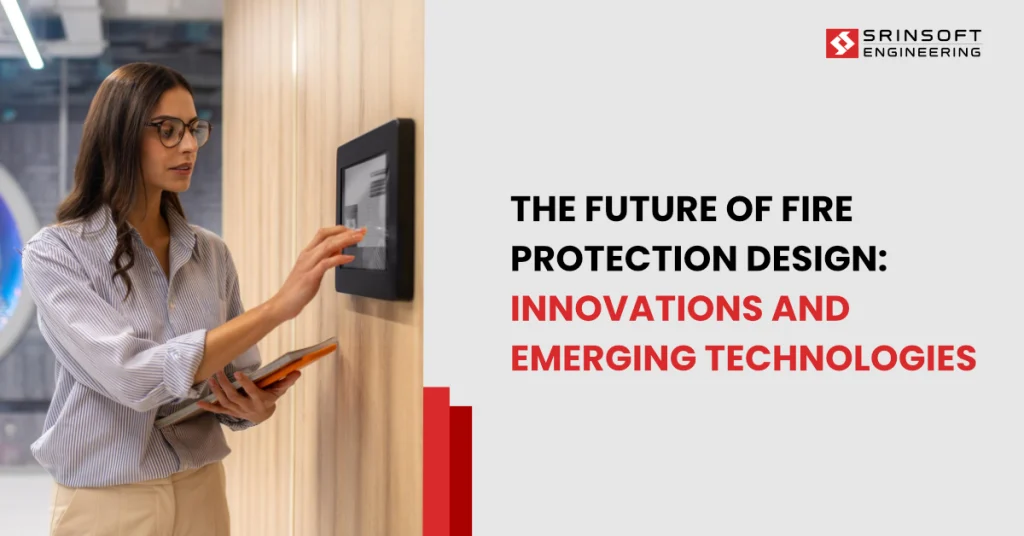
What is Fire Protection Design?
Fire protection design involves creating & implementing measures to prevent, detect, and respond to fires.
It encompasses everything from fire alarms, sprinkler systems to fire-resistant building materials & evacuation plans.
The goal is to minimize the risk of fire, its potential damage to both property & human life.
Key Components of Fire Protection Design
There are several key components to effective fire protection design:
- Fire Detection Systems: Smoke detectors, heat detectors, fire alarms that alert occupants & authorities to the presence of a fire.
- Fire Suppression Systems: Sprinkler systems, fire extinguishers & other equipment designed to control or extinguish fires.
- Fire-Resistant Materials: Building materials that can withstand high temperatures & prevent the spread of fire.
- Evacuation Plans: Clearly defined routes & procedures for safely exiting the building during a fire.
Introduction to Fire Protection Design Automation
What is Fire Protection Design Automation?
Fire protection design automation uses advanced technologies & software to automate fire protection systems’ planning, implementation &management.
This can include everything from CAD (computer-aided design) software to automated testing & monitoring systems.
History & Evolution of Fire Protection Automation
Advancements in technology have driven the evolution of fire protection automation.
Initially, fire protection systems were manually operated & monitored.
With the advent of digital technologies, automation began to play a significant role, improving both efficiency & effectiveness.
Current Trends in Fire Protection Design Automation
Today, the integration of AI & IoT (Internet of Things) technologies is leading to smarter, more responsive fire protection systems.
These systems can predict potential fire hazards, provide real-time data & automate responses to fire incidents, making buildings safer than ever before.
1. Integration of AI & Machine Learning:
These technologies predict potential fire hazards by analyzing patterns & data. They also optimize safety systems for better performance. This leads to smarter, more efficient fire protection.
2. IoT-Enabled Systems:
Devices communicate and respond in real-time, providing continuous monitoring. This connectivity ensures immediate alerts & actions. It enhances the overall reliability of fire safety systems.
3. Cloud-Based Solutions:
These solutions allow remote management of fire safety systems. Real-time data access helps in making quick decisions. They also facilitate easier updates & maintenance.
4. Advanced Detection Technologies:
New technologies like video smoke detection offer more accurate fire detection. They reduce false alarms and improve response times. This ensures a higher level of safety.
5. Automated Suppression Systems:
These systems activate automatically when a fire is detected. They control fires faster than manual systems. This reduces potential damage and enhances safety.
6. Data Analytics:
Analyzing data helps in predicting maintenance needs and system performance. This proactive approach prevents failures. It ensures that fire protection systems are always in optimal condition.
7. Smart Building Integration:
Fire systems are integrated with smart building technologies. This allows for coordinated responses to emergencies. It improves overall building management efficiency.
8. VR and AR Training:
Virtual and augmented reality technologies provide realistic training scenarios. They help personnel prepare for real-life fire emergencies. This improves readiness and response efficiency.
9. Compliance Tools:
Automated tools ensure fire protection systems meet safety regulations. They simplify the process of maintaining compliance. This helps avoid legal issues and ensures safety standards are met.
10. Energy-Efficient Systems:
New fire protection designs focus on reducing energy consumption. They are more environmentally friendly. This contributes to overall sustainability goals.
11. Customized Solutions:
Automation allows for tailored fire protection systems. These solutions meet the specific needs of different buildings. Customization ensures effective and efficient protection.
12. Wireless Alarm Systems:
These systems are easy to install and highly reliable. They offer flexibility and scalability. Wireless technology also simplifies system upgrades and maintenance.
13. Emergency Management Integration:
Fire protection systems are integrated with broader emergency management plans. This coordination improves response to various emergencies. It ensures a comprehensive safety approach.
14. Blockchain for Data Security:
Blockchain technology secures fire safety data. It ensures that information is tamper-proof and reliable. This enhances the integrity of fire protection records.
15. 3D Modeling:
3D modeling tools help in planning and testing fire protection systems. They provide accurate visualizations and simulations. This leads to better design and implementation.
16. Real-Time Reporting:
Automated systems offer immediate incident reporting and analysis. This allows for faster responses to fires. Quick analysis helps in understanding and improving fire safety measures.
17. Drones for Inspection:
Drones provide safe & comprehensive monitoring of large areas. They can access hard-to-reach places easily. This enhances the effectiveness of fire system inspections.
18. Biometric Access Control:
Integrating biometric technology enhances security. Only authorized personnel can access critical areas. This prevents unauthorized access and potential safety breaches.
19. User-Friendly Interfaces:
Modern fire protection systems have simplified control interfaces. This makes them easier to manage and monitor. User-friendly designs improve overall system usability.
20. Mobile Apps:
Mobile applications allow remote management of fire safety systems. They provide real-time alerts and control options. This ensures constant vigilance and quick response.
21. Green Building Certifications:
Fire protection systems now support sustainability goals. They help buildings achieve certifications like LEED. This alignment promotes environmental responsibility.
22. BIM Integration:
Building Information Modeling (BIM) improves planning and management. It allows for detailed visualization and coordination. BIM integration enhances the effectiveness of fire protection designs.
23. Cybersecurity:
Protecting fire safety systems from digital threats is crucial. Robust cybersecurity measures are implemented. This ensures system integrity and reliability.
24. Adaptive Systems:
Intelligent fire protection systems adjust to changes in building layout and occupancy. They provide dynamic and responsive safety measures. This adaptability ensures continuous protection.
25. Augmented Maintenance Support:
Augmented reality provides visual guidance for maintenance tasks. This improves accuracy & efficiency in repairs & inspections.
26. Voice-Activated Controls:
Voice-activated controls offer hands-free operation. This allows for quicker & safer responses during emergencies. It enhances the usability of fire protection systems.
27. HVAC Integration:
Integrating fire protection with HVAC systems controls smoke spread. It maintains air quality during a fire event. This integration improves overall building safety.
28. Automated Reporting:
Automated tools generate necessary compliance documents. This simplifies the auditing & reporting process. It ensures that records are accurate & up-to-date.
29. Collaborative Platforms:
Platforms for collaboration improve teamwork among stakeholders. They facilitate better communication and coordination. This leads to more effective fire protection designs and implementations.
30. AI-Driven Risk Assessment:
AI tools provide detailed risk assessments. They tailor fire protection measures based on these assessments. This ensures a customized and effective safety strategy.
Benefits of Fire Protection Design Automation
1. Increased Efficiency:
Automation speeds up the design process, significantly reducing the time required. This allows projects to be completed faster, meeting tight deadlines. Overall, it enhances productivity.
2. Cost Savings:
Automation lowers labor costs by reducing the need for manual work. It also minimizes costly mistakes during the design and installation phases. Ultimately, it saves money for both builders & property owners.
3. Data-Driven Decisions:
Automation provides valuable data for analyzing system performance. This data helps optimize fire protection strategies. Decision-makers can make informed choices based on accurate information.
4. Scalability:
Automated systems can easily adapt to buildings of different sizes. They are flexible enough to meet the specific needs of various projects. This scalability makes them suitable for both small and large structures.
5. Flexibility:
Customizable solutions cater to the unique requirements of different buildings. Automation allows for tailored fire protection designs. This flexibility ensures that each building gets the protection it needs.
6. Remote Access:
Automation enables the remote management and monitoring of fire protection systems. This convenience allows facility managers to oversee systems from anywhere. It ensures constant vigilance and quick intervention when needed.
7. Improved Training:
VR and AR technologies provide realistic training scenarios. This improves the effectiveness of training programs. Personnel are better prepared to handle real-life fire emergencies.
8. Energy Efficiency:
Automated fire protection systems are designed to use minimal energy. This reduces the overall energy consumption of the building. Energy-efficient systems contribute to sustainability goals.
9. Enhanced Documentation:
Automation generates detailed reports and records automatically. This ensures accurate and up-to-date documentation. Enhanced documentation simplifies compliance and auditing processes.
10. Better Resource Allocation:
Data insights from automated systems help optimize resource use. This leads to more efficient allocation of manpower and materials. Better resource management enhances overall system performance.
11. Compliance with Green Standards:
Automated systems support sustainability and green building standards. They help buildings achieve certifications like LEED. Compliance with green standards promotes environmental responsibility.
12. Enhanced Communication:
Integrated systems provide clear and consistent information. This improves communication between different safety and management teams. Enhanced communication ensures coordinated and effective responses.
How Automation Enhances Building Safety
1. Improved Safety:
Automated systems detect fires early and respond quickly. This rapid action protects lives and reduces property damage. Enhanced safety measures ensure a higher level of security for all occupants.
2. Regulatory Compliance:
Automation ensures that fire protection systems meet all current safety standards. It keeps systems up-to-date with changing regulations.
3. Real-Time Monitoring:
This proactive approach helps maintain optimal system performance – Immediate identification of issues, automated alerts enable quick responses to potential problems.
4. Predictive Maintenance:
Predictive maintenance ensures systems are always in top working condition.
5. Faster Incident Response:
Automated systems provide immediate alerts and actions in case of fire. This rapid response minimizes damage and enhances safety.
6. Reduced Downtime:
Reduced system downtime ensures fire protection systems are always operational. It means continuous safety and protection.
7. Integration with Other Systems:
This integration allows for coordinated responses in emergencies. It enhances the overall functionality of building management systems.
Implementing Fire Protection Design Automation
Steps to Implement Automation in Fire Protection Design
- Assess Current Systems: Evaluate existing fire protection measures to identify areas for improvement.
- Define Objectives: Determine the goals of the automation project, such as increased safety, compliance, or cost savings.
- Select Tools and Technologies: Choose the right software and hardware solutions to meet your objectives.
- Develop a Plan: Create a detailed plan for implementing the automation, including timelines and milestones.
- Implement the Plan: Execute the plan, ensuring all systems are properly installed and configured.
- Test and Validate: Thoroughly test the automated systems to ensure they work as intended.
Frequently Asked Questions
What is fire protection design automation?
Fire protection design automation involves using technology to plan, implement, and manage fire protection systems more efficiently and accurately.
What are the cost benefits of automating fire protection design?
Automating fire protection design can save significant costs by streamlining processes, reducing manual labor, and ensuring optimal system configuration.
What are some challenges in implementing fire protection design automation?
Challenges include resistance to change, technical issues, and the initial cost of implementation. These can be addressed through proper training, support, and demonstrating the long-term benefits.
How can I get started with fire protection design automation?
To get started, assess your current systems & develop a detailed plan
Or you can always reach out to our experts by clicking Here.


